Discover The Best Things To Do Outside Of Taipei
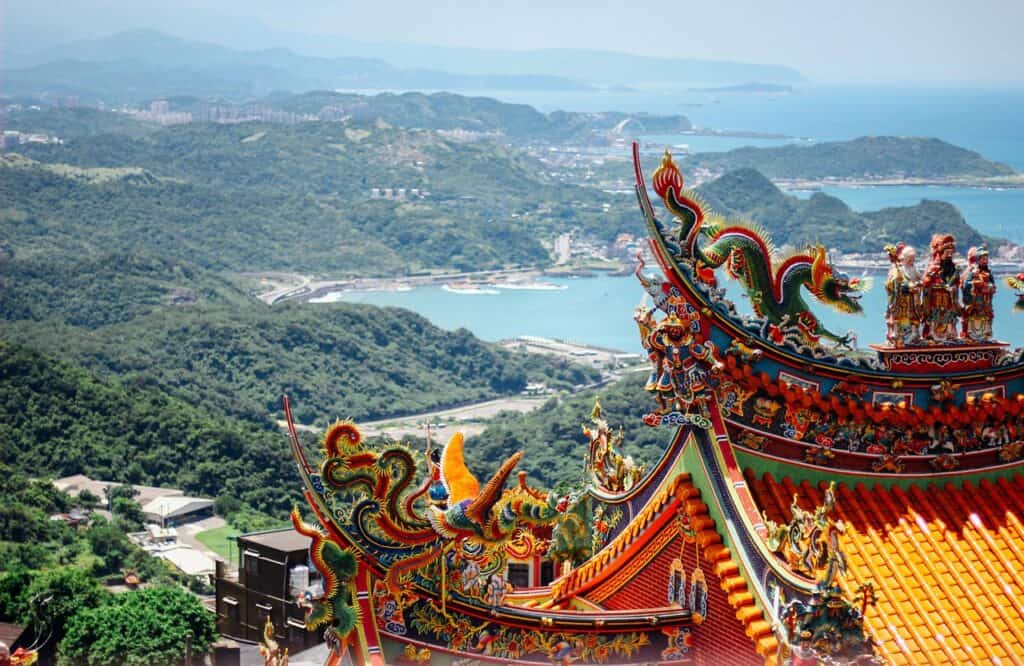
Vacationing in Taiwan usually conjures up images of bustling Taipei, the island’s capital city, full of modern skyscrapers, glitzy shopping centres, museums, historic neighbourhoods and food markets. However, just beyond the outskirts of this city, there are so many great things to do outside the capital. So, in this Blog post we will give you the best things to do outside Taipei that make for a great day trip or weekend away. So let’s get started.
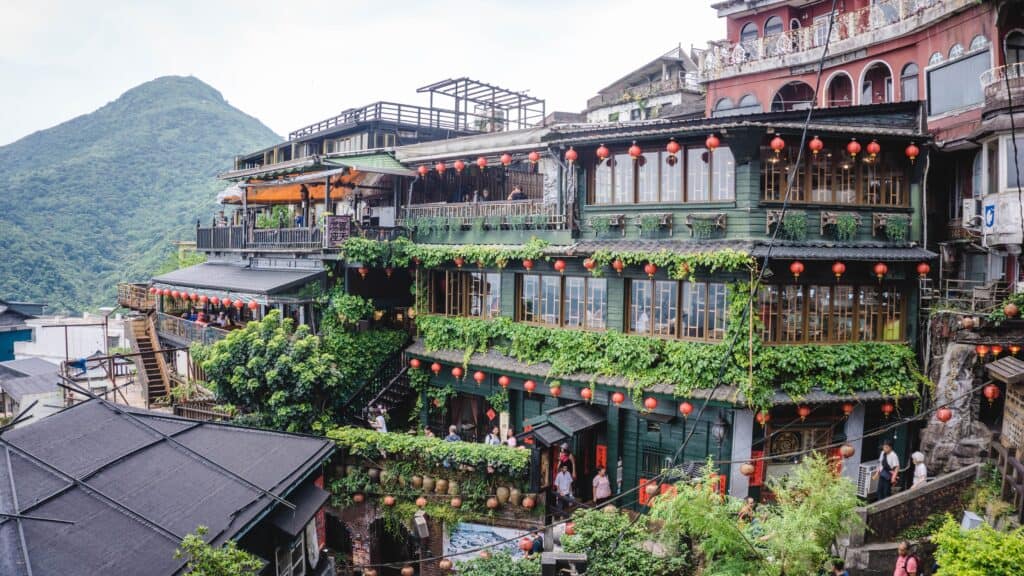
Jiufen
Jiufen is a picturesque old town that exudes an enchanting charm unlike any other. With its narrow streets, tea houses and red lanterns, this quaint hillside village has captivated the hearts of many visitors and may have inspired the classic Studio Ghibli’s movie Spirited Away.
Jiufen, which literally translates to “nine portions,” was once a small village of only nine families. Its fortunes changed dramatically during the Japanese occupation when gold was discovered and the town quickly transformed into a bustling hub of miners and merchants.
The town’s main thoroughfare, Jishan Street, is lined with charming food stalls, teahouses and souvenir shops.
One of the best things to do in Jiufen is the A-Mei Tea House. This beautifully preserved Japanese style building has become a symbol of the town and offers a chance to experience traditional Taiwanese tea culture while soaking in the breathtaking views of the surrounding landscape.
Getting There: Jiufen is easily accessible from Taipei and has a number of public transport options. One of the easiest and quickest ways is to use the tourist shuttle bus service; which takes approx 75 mins to get to there.
Jinguashi Gold Ecological Park
Jinguashi Gold Ecological Park offers a great opportunity to delve into Taiwan’s fascinating mining history. The park is home to several attractions including:
The Gold Museum: This museum offers a comprehensive overview of Jinguashi’s mining history and gold-related exhibits. Here, you can learn about the geology of the region, the process of gold extraction, and even admire the world’s largest gold brick weighing an impressive 220 kg.
Benshan Fifth Tunnel: For a more immersive experience, take a tour of the Benshan Fifth Tunnel, a former mine that has been transformed into an educational exhibit.
Japanese-Style Residences and the Crown Prince Chalet: This park has a number of beautifully preserved Japanese-style residences that once housed the mine’s executives and their families. The most notable among them is the Crown Prince Chalet, a charming wooden structure built for the visit of Japan’s Crown Prince Hirohito in 1923. Although he never actually stayed there, the chalet remains an architectural gem that showcases the Japanese influence on Jinguashi during its mining heyday.
Cyuanji Temple and Shinto Shrine: Religion played a significant role in the lives of the miners, providing them with spiritual solace in the face of danger and hardship. The park is home to the beautiful Cyuanji Temple, a Taoist place of worship built and nearby are the remains of a Shinto temple.
The park is open Saturday & Sunday 09:30-18:00 and Monday to Friday 09:30-17:00. Entrance tickets can be purchased at the Information Centre.
Getting There: Jinguashi Gold Ecological Park is easily accessible from Taipei via public transportation using the MRT to Zhongxiao Fuxing Station and then board the bus which directly transports you to Jinguashi.

Pingxi District
The Pingxi District, nestled in the picturesque mountains of New Taipei City, is a charming destination steeped in history and natural beauty. Known for its historic streets and the enchanting Sky Lantern Festival, Pingxi offers a glimpse into Taiwan’s rich cultural heritage while also providing the opportunity to explore its stunning landscapes.
The district boasts several popular attractions, such as the historic town of Shifen which excludes an air of nostalgia and the Shifen Waterfall, a breathtaking 40-metre cascade.
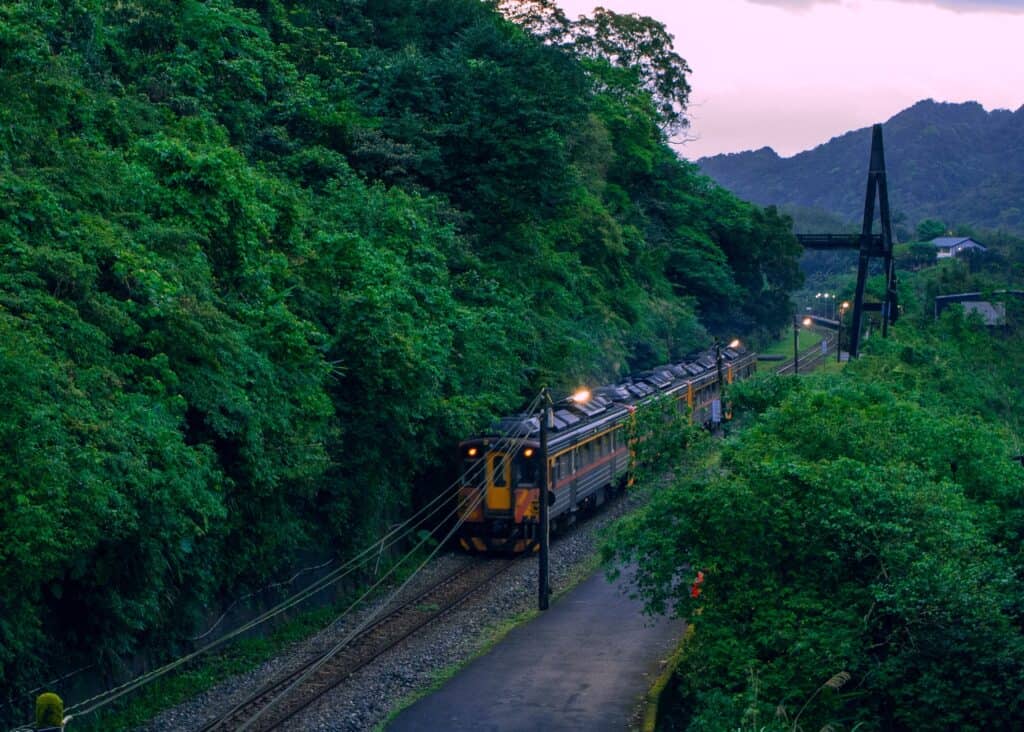
Pingxi Railway
No trip to Pingxi District would be complete without a ride on the historic Pingxi Railway. This narrow-gauge railway, approximately 12km, was built during the Japanese colonial era to transport coal and today offers a relaxing and scenic journey through the district’s lush landscapes and charming towns and villages.
A Pingxi Line day ticket can be purchased from Ruifang Station and is a great way to travel through the district, as the train stops at many of the attractions.
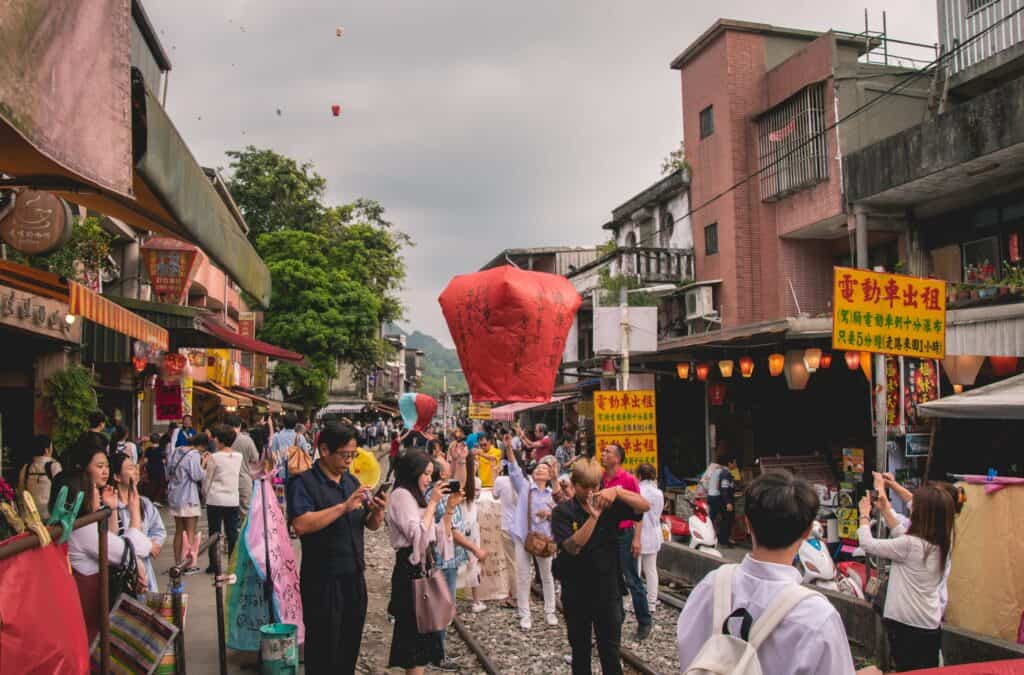
Shifen
A visit to the charming town of Shifen promises a delightful and memorable experience for travellers seeking a blend of natural beauty, rich cultural heritage, and a taste of local life.
Take a leisurely stroll along the Shifen Old Street lined with lantern-lit shops where you can find an assortment of local snacks, souvenirs, and handicrafts.
Shifen is renowned for its annual Sky Lantern Festival, a mesmerising event that sees thousands of paper lanterns released into the night sky creating a breathtaking spectacle.
While the main festival takes place during the Lunar New Year, you can still experience the lantern tradition year-round by purchasing and releasing a lantern.
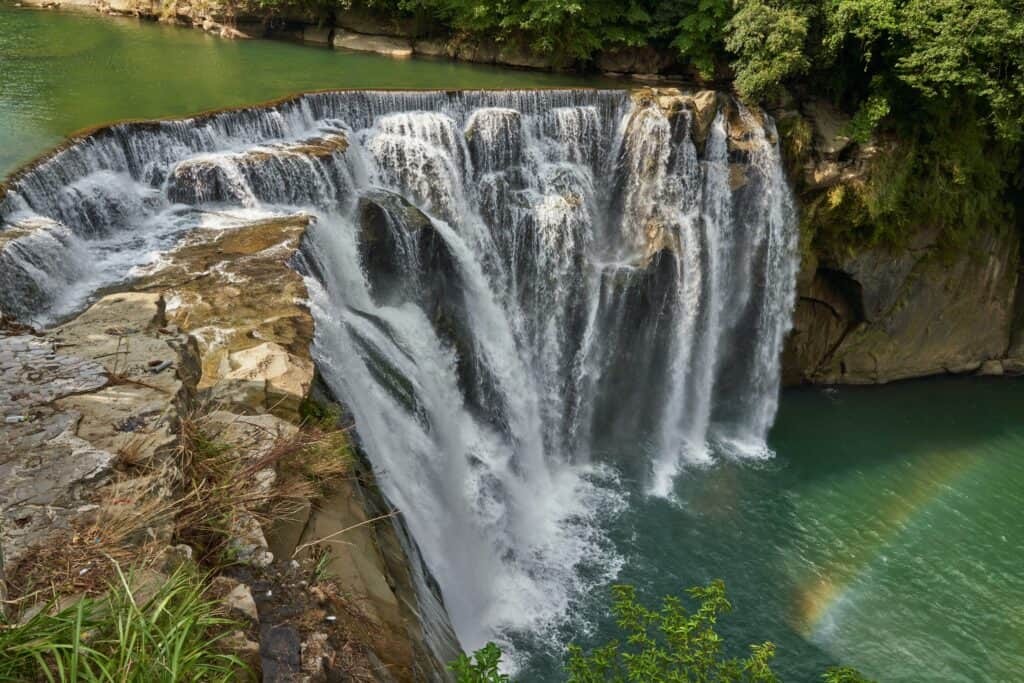
Waterfalls & Hikes
Pingxi district is home to several stunning waterfalls, including the famous Shifen Waterfall, also known as the “Niagara of Taiwan.” This 20-metre-tall, 40-meter-wide waterfall is a sight to behold, surrounded by lush greenery and accessible through a scenic walkway.
This district also has many hiking trails with various levels of difficulty. One popular trail is the hike to Xiaozi Mountain, which rewards climbers with a breathtaking panoramic view of the surrounding mountains and valleys. Other notable trails include the Pingxi Crags and the Lingjiao Waterfall Trail.
Another popular hiking trail, is the Sandiaoling Waterfall Trail, which is a moderately challenging hike that spans approximately 5kms and takes around 3-4 hours to complete. The well-marked trailhead begins at Sandiaoling Station and leads you along a picturesque path, following the course of the Keelung River.
The Sandiaoling Waterfall Trail is home to several waterfalls, each with its unique charm and beauty. As you hike, you’ll have the opportunity to witness and admire these natural wonders up close.
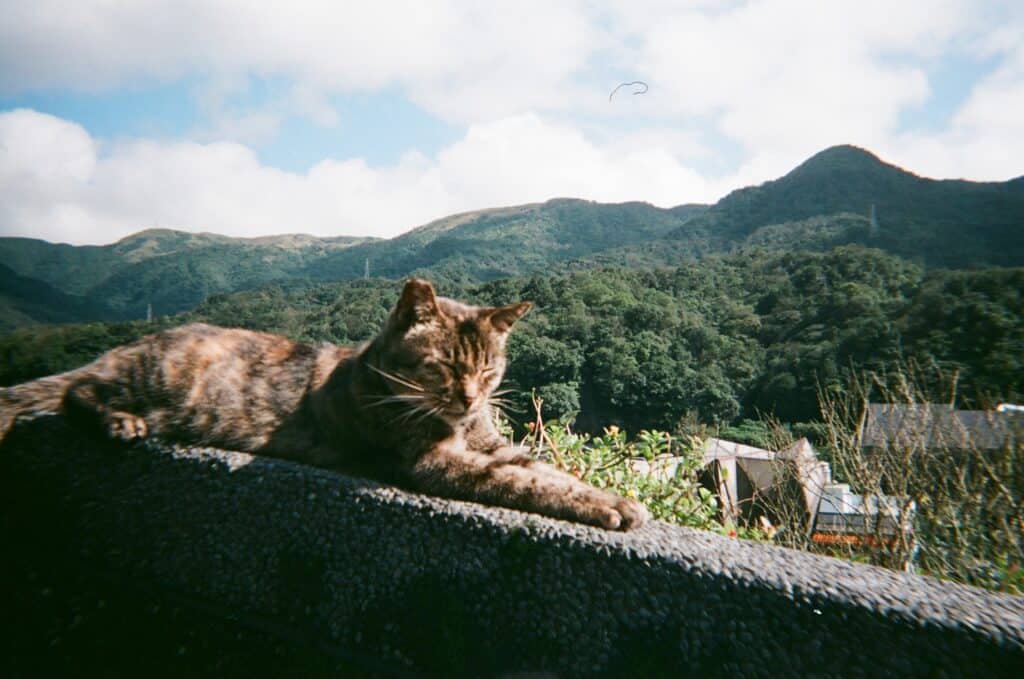
Houtong Cat Village
If you’re a cat lover, then Houtong Cat Village is a great stop on the Pingxi Line. Houtong’s history dates back to the early 20th century when the village was a thriving coal mining community. However, as Taiwan’s coal industry began to decline in the 1990s, the population of Houtong dwindled, and the once-bustling town was left nearly abandoned.
In 2008, a local cat enthusiast named Peggy Chien started a project to care for the numerous stray cats that had made Houtong their home. Today, Houtong Cat Village is home to over 100 well-cared-for cats and is filled with cat themed shops and cafes.
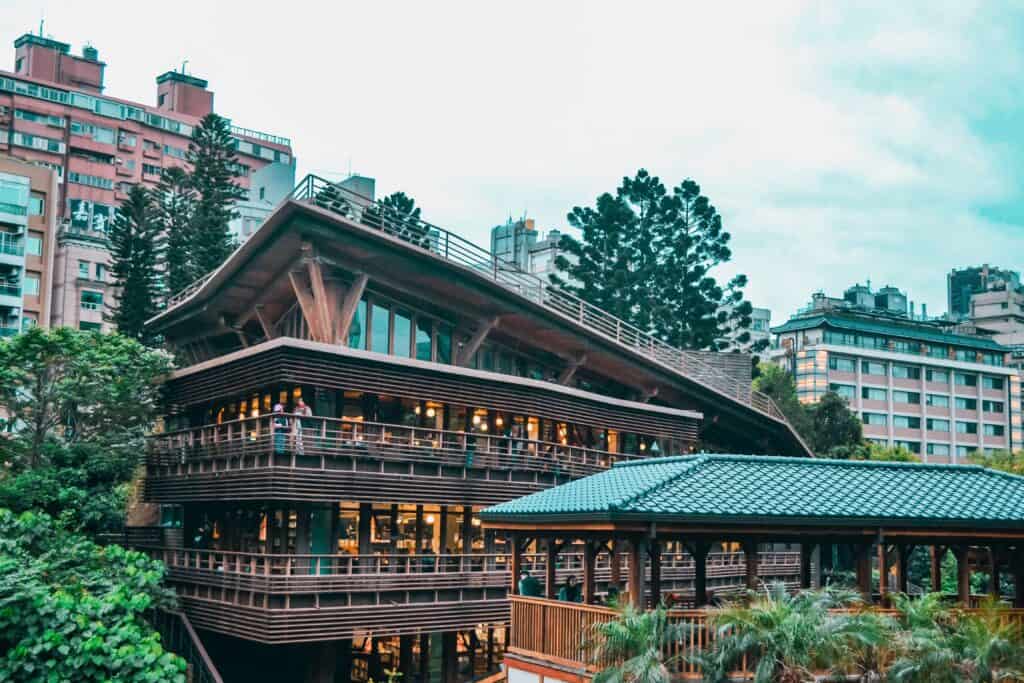
Beitou Hot Spring
Nestled amidst lush green hills and flourishing forests lies one of Taiwan’s most famous attractions – Beitou Hot Spring.
This natural wonder, located in the northern part of Taipei City, has been a popular destination for those seeking relaxation and rejuvenation.
The enchanting hot spring of Beitou has a rich history that dates back to the late 19th century when Taiwan was under Japanese rule. Beitou was developed as a hot spring resort town, and it quickly gained popularity among the Japanese who were captivated by its breathtaking scenery and soothing waters. The name “Beitou” is derived from the indigenous Ketagalan word “Paktaaw” which means “witch,” as the local tribes believed that the steam rising from the hot springs was caused by the magic of witches.
These are the key attractions in the area:
Thermal Valley: Also known as “Hell Valley”, Thermal Valley is a mesmerising sight with its jade-green sulphuric hot spring lake and clouds of steam rising from its surface. The area is surrounded by lush vegetation, creating a serene atmosphere that is perfect for taking a leisurely stroll and soaking in the beauty of nature.
Beitou Hot Spring Museum: Housed in a charming Japanese-style building, this museum gives you the history and culture of Beitou’s Hot Spring. The museum features historical artefacts, and engaging exhibits that showcase the development of Beitou as a hot spring resort town.
Beitou Library: This eco-friendly building can be spotted at the centre of town near the station and is Taiwan’s first green library.
Public and Private Hot Spring Baths: Beitou offers a wide range of hot spring bathing options, from public pools to private rooms in luxurious hotels. If you are using one of the public pools, make sure you take a bathing suit, towel and soap.
Getting There: Easily accessible from Taipei via the MRT Red Line. Simply take the train to Beitou Station and then transfer to the Xinbeitou branch line (pink line for two stops), which will bring you directly to the heart of Beitou Hot Spring area.
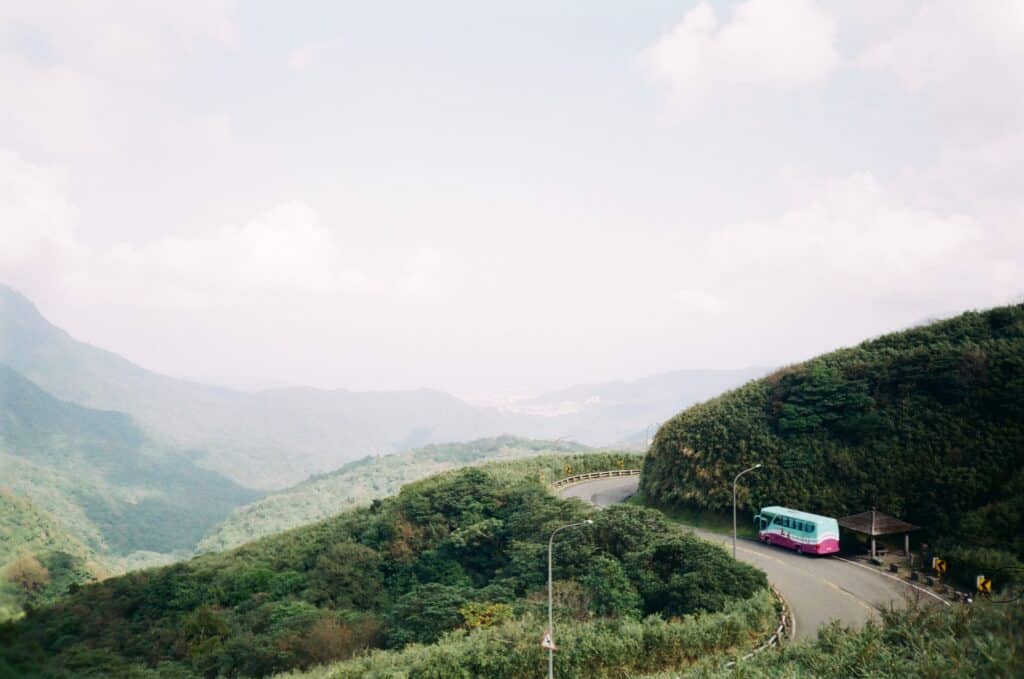
Yangmingshan National Park
Yangmingshan National Park is an ideal destination for a day trip or long weekend from Taipei due to its close proximity, diverse attractions, and easy accessibility.
Located just about 15 kilometers north of Taipei, the park can be reached within an hour by public transportation or private vehicle, making it a convenient escape city life.
Yangmingshan’s stunning landscape features lush forests, rolling grasslands, hot springs, and volcanic geology, provides you with a wide range of activities such as hiking, birdwatching, and relaxing in natural hot springs. Moreover, the park is home to various flora and fauna, offering nature enthusiasts a chance to explore Taiwan’s unique biodiversity.
Yangmingshan boasts a vast network of hiking trails that cater to all levels of fitness and experience. From leisurely strolls through forests to challenging treks up dormant volcanoes, there is a trail to suit every type of adventurer.
For those seeking a more challenging hike, the Mt. Qixing trail offers a thrilling ascent to the summit of Taipei’s highest peak. This moderately difficult trail takes you through lush forests and past steaming fumaroles before culminating in a spectacular viewpoint offering panoramic views of the national park and city.
Another great reason to visit Yangmingshan National Park is its spectacular floral displays. The annual Yangmingshan Flower Festival, held between February and April, is a great time to visit, when most of the flowers are in full bloom.
Getting There: The most popular way of getting to the national park is to the take the MRT to either Beitou, Jiatan or Shipai stations and then take the bus to the park. Private cars and taxis can also be easily hired for a more comfortable and effective trip.
Jinshan Hot Spring
Jinshan Hot Spring known for its therapeutic waters rich in minerals is a popular day trip for locals and tourists seeking relaxation.
While the hot springs are undoubtedly the main attraction, Jinshan and its surrounding areas offer plenty of opportunities for exploration. The nearby Jinbaoli Old Street is a charming thoroughfare lined with traditional shops, teahouses, and street food vendors, offering a taste of local culture and cuisine.
Getting There: Jinshan Hot Springs from Taipei is a straightforward. Take the MRT Tamsui-Xinyi (Red) Line to Tamsui Station, and then take the bus which will transport you directly to Jinshan Hot Springs. Alternatively, you can opt for a taxi or private car service for a more comfortable and convenient journey.
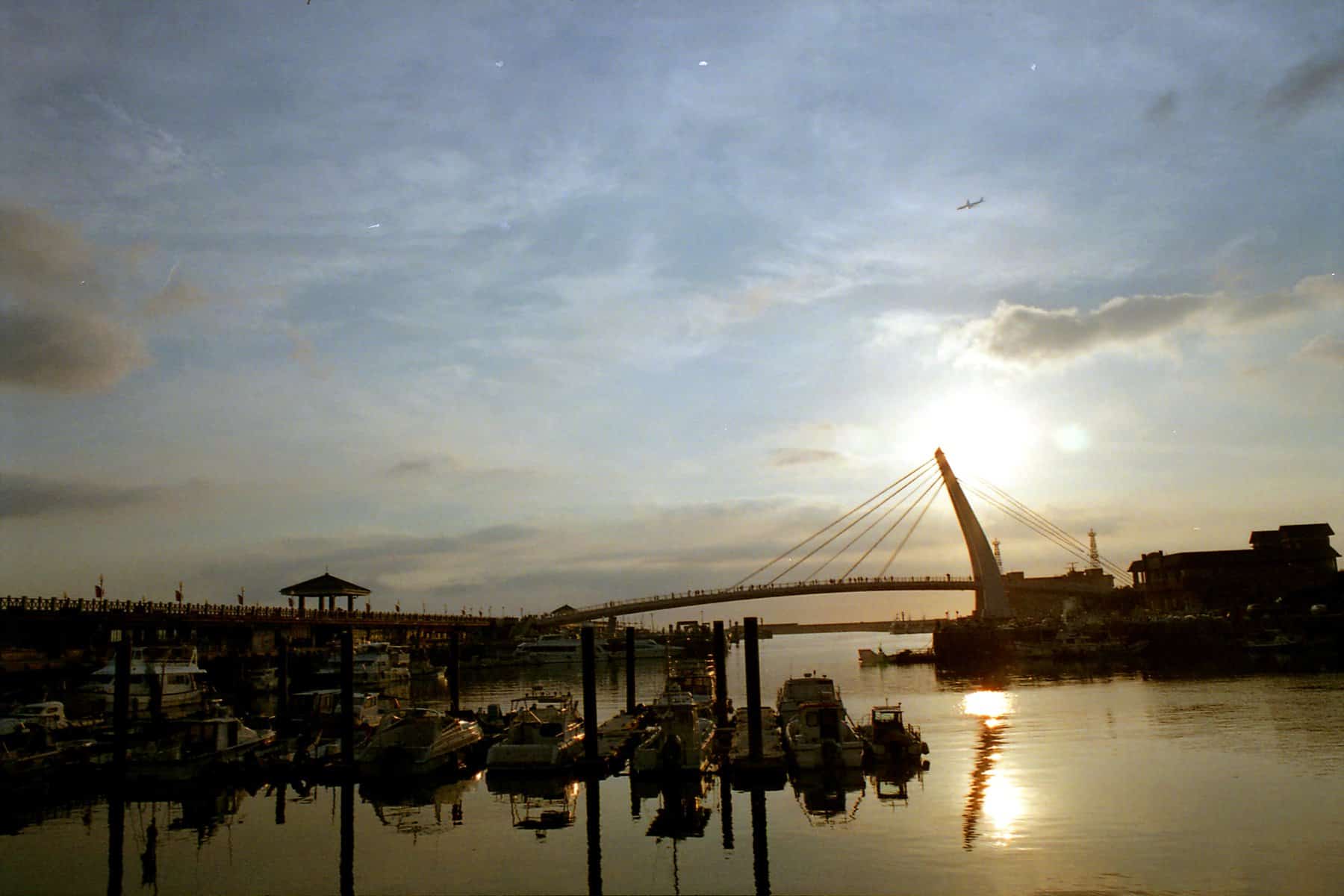
Tamsui (Danshui)
Located just north of Taipei is the quaint riverside town of Tamsui (also known as Danshui) filled with history, stunning views of the surrounding countryside, and mouth-watering street food.
Established in the 17th century, the town played a significant role in Taiwan’s colonial past, serving as a major trading port during the Spanish and Dutch occupations, and later during the Qing Dynasty. As a result, Tamsui’s architecture and culture are a unique blend of indigenous, European, and Chinese influences, offering visitors a captivating window into Taiwan’s diverse heritage.
Key things to do in Tamsui include:
Old Street: No trip here is complete without strolling down the bustling Old Street. This lively pedestrian area is lined with shops selling traditional handicrafts, souvenirs, and delicious street food. Be sure to try the famous “A-Gei” – a local specialty made of fried tofu stuffed with glass noodles and topped with a savory sauce.
Fort San Domingo: This historic fortress, also known as the “Red Hair Castle,” was built by the Spanish in 1629 and later taken over and rebuilt by the Dutch. The fort offers a fascinating insight into Tamsui’s colonial past, and its elevated location provides sweeping views of the Tamsui River and surrounding landscape.
Hobe Fort: Very close to Fort San Domingo is Hobe Fort, which was built during the Qing Dynasty, the fort was designed to protect the region from potential foreign invasions. While exploring Hobe Fort, you’ll be rewarded with panoramic views of the Tamsui River and surrounding landscapes.
Tamsui Customs Officer’s Residence: Also known as the Little White House, this building served as the residence of British customs officers during the Qing Dynasty and is now museum.

Fisherman’s Wharf: This is a popular spot for enjoying the Tamsui river area. In addition to walking on the waterfront, key attractions also include the “Lover’s Bridge,” and “Lover’s Tower’. This is. great spot for watching the sun set over the river.
Getting There: Reaching Tamsui from Taipei is a breeze, thanks to the city’s efficient MRT system. Simply hop on the MRT Red Line and ride it all the way to the last stop which is Tamsui Station.
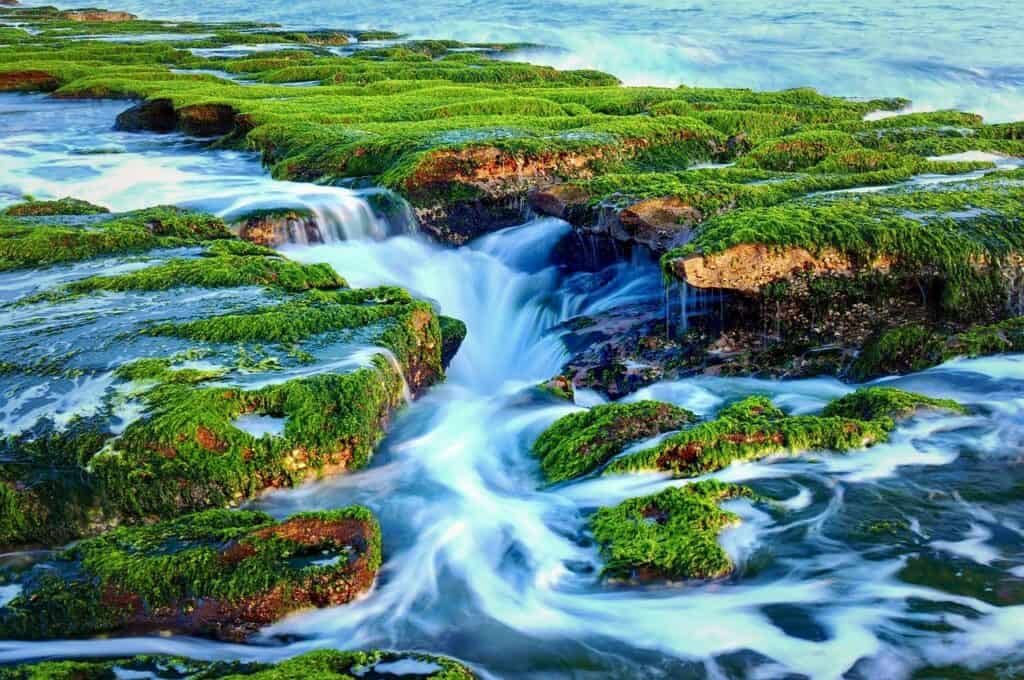
Fuguijiao Lighthouse & Laomei Green Reef
Fuguijiao Lighthouse and Laomei Green Reef are located at the northern tip of the island and are stunning landmarks.
Perched atop of Fugui Cape, Fuguijiao Lighthouse was built in 1897 during the Qing Dynasty and served as a vital navigational aid for ships traversing the waters of the Taiwan Strait.
Just south of Fuguijiao Lighthouse lies Laomei Green Reef. This fascinating geological formation is a result of volcanic activity and subsequent erosion, creating a series of striking troughs and grooves along the shoreline. A great spot for nature photographers. (The best time to visit is April/May).
Getting There: Both Fuguijiao Lighthouse and Laomei Green Reef are easily accessible from Taipei by car or public transportation (approx. 50km). If you are using the MRT, take the MRT Red Line to Tamsui Station and then take the bus or shuttle bus.
Juming Museum
Located in the Jinshan District in New Taipei City, the Juming Museum is a must-visit destination for art enthusiasts seeking to explore the exceptional talent of one of Taiwan’s most celebrated artists, Ju Ming. Spread across a sprawling 11-hectare compound, this stunning open-air museum showcases hundreds of Ju Ming’s sculptures, providing an immersive experience into the creative mind of this renowned sculptor.
Getting There: The Juming Museum is easily accessible from Taipei via public transportation or a short drive. If using public transport, take the MRT to Tamsui-Xinyi (Red) Line to Tamsui Station and take the bus directly to Juming Museum.
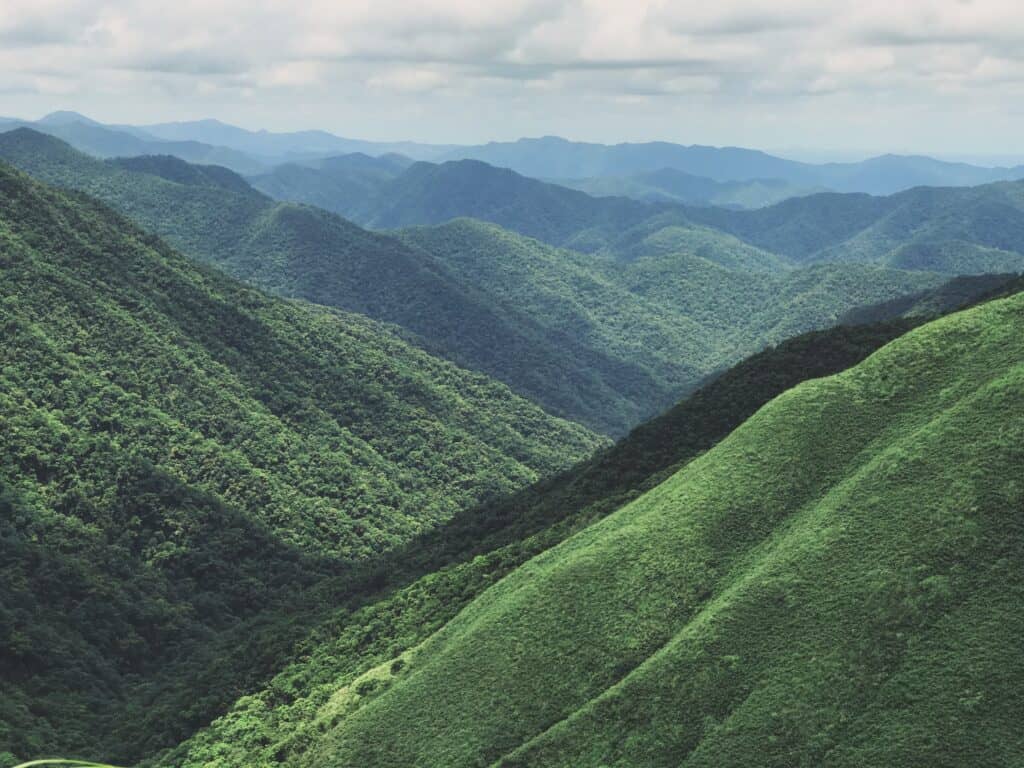
Pinglin
Pinglin is a serene haven for tea lovers and nature enthusiasts. This quaint town, renowned for its high-quality Baozhong (Pouchong) tea, offers a great day out for its picturesque tea plantations, soothing landscapes, and rich tea culture.
Tea has been at the heart of Pinglin’s history and economy for centuries, with the region’s unique climate and fertile soil creating ideal conditions for cultivating exceptional tea leaves. As you explore the town, you’ll encounter numerous tea houses and shops where you can sample and purchase the local Baozhong tea – a lightly fermented, floral green tea prized for its delicate flavour and aroma.
If you want to gain a deeper understanding of Pinglin’s tea heritage, a visit to the Pinglin Tea Museum is a must. This informative museum provides a comprehensive overview of Taiwan’s tea history, production process, and brewing techniques through engaging exhibits and interactive displays.
For a more adventurous excursion, venture into the hills surrounding Pinglin to explore the numerous hiking trails, such as the Shiding Thousand Island Lake Trail or the Beishi Old Stream Trail. These paths offer varying levels of difficulty and reward hikers with breathtaking vistas of tea plantations, mountain peaks, and lush valleys.
Getting There: Pinglin is easily accessible from Taipei via public transportation or a short drive. If using the MRT, start at Xindian Station (Green Line) and from there take a bus right outside the station.
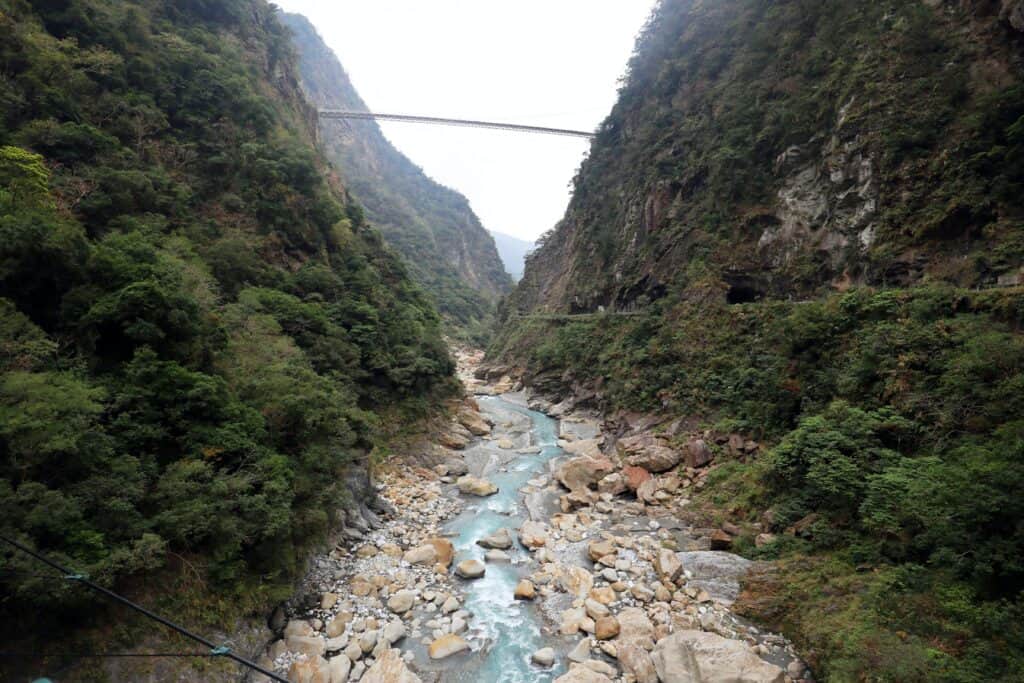
Taroko National Park / Taroko Gorge
Taroko National Park is named after its crown jewel, the Taroko Gorge, which was formed by the relentless erosion of the Liwu River over millions of years. The park features diverse landscapes, ranging from towering marble cliffs and lush forests to serene rivers and cascading waterfalls. This natural paradise is home to numerous endemic species of flora and fauna, making it an ideal destination for wildlife enthusiasts and photographers.
The Taroko Gorge is undoubtedly the main attraction of the national park. This massive marble canyon stretches for 19 kms and reaches depths of up to 3,000 meters. The gorge’s striking marble walls change colors throughout the day, creating a mesmerizing display for visitors. Hiking through the gorge is a popular activity, with several well-maintained trails offering varying levels of difficulty.
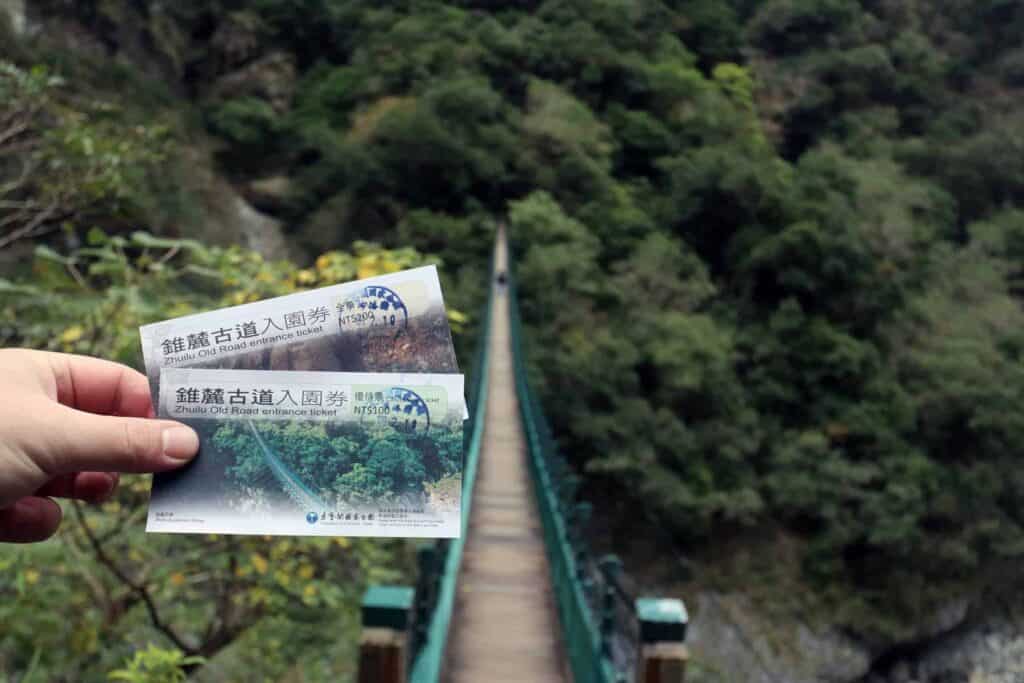
Zhuilu Old Trail
For those seeking a more challenging hike, the Zhuilu Old Trail is a must-try. This 3.1-kilometer trail was originally built by the indigenous Truku people and later used by the Japanese during their occupation of Taiwan. The trail takes you along a narrow cliffside path, providing breathtaking views of the gorge below. Note that permits are required for this hike and can be obtained through the Taroko National Park website.
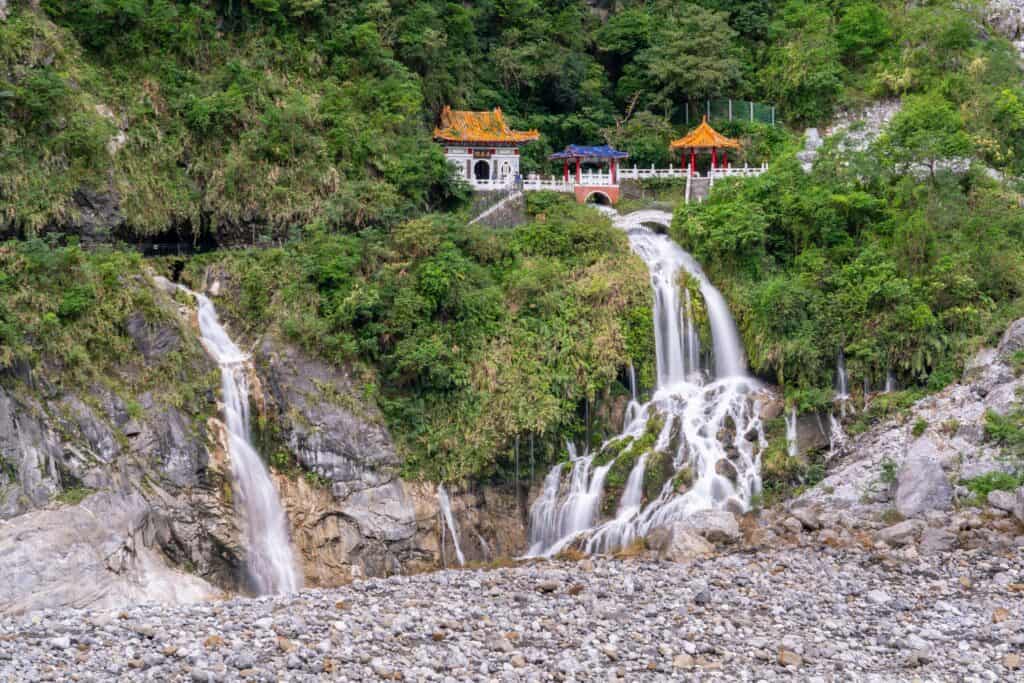
Eternal Spring Shrine (Changchun Shrine)
The Eternal Spring Shrine is a picturesque landmark nestled within the park. It was built to commemorate the 226 workers who lost their lives during the construction of the Central Cross-Island Highway. The shrine is perched above a waterfall, creating a serene and tranquil atmosphere. A short hike to the shrine offers visitors a chance to pay their respects while also enjoying the surrounding natural beauty.
Getting There: Approximately 150km from Taipei, one for the most convenient and fastest ways is to take the Taiwan High-Speed Rail (THSR) from Taipei Main Station to Hualien Station. Once in Hualien, transfer to a local bus or taxi.

Wulai
Nestled in the lush mountains just south of Taipei, Wulai is a hidden gem that offers a unique blend of natural beauty, cultural heritage, and relaxation. Known for its hot springs, picturesque waterfalls, and rich indigenous culture, this charming area is an ideal destination for a day trip or weekend away.
Wulai is also home to the Atayal tribe, one of Taiwan’s 16 recognized indigenous group, so the area also offers a fascinating glimpse into the traditional way of life, customs, and artistry of the Atayal people.
A stroll down Wulai Old Street is a must when visiting the village. This lively market street is lined with shops selling traditional Atayal handicrafts, local snacks, and souvenirs.
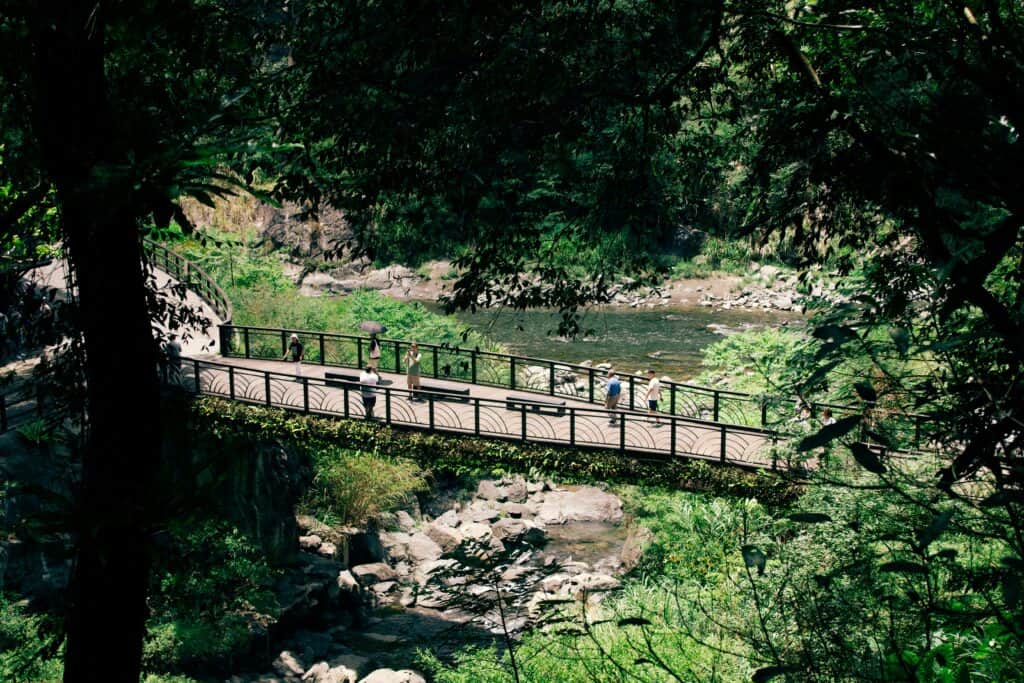
Hot Springs & Hikes
Wulai is famous for its abundance of natural hot springs and there are numerous hot spring facilities in the area, ranging from public bathhouses to luxurious spa resorts.
For those seeking a more authentic and budget-friendly experience, Wulai’s public hot springs are an excellent option. Located along the banks of the Nanshi River, these outdoor pools are free to use and offer a relaxing soak amidst the surrounding natural beauty. Remember to bring your own towel and bathing suit and soap.
The stunning landscape surrounding Wulai is perfect for those who love outdoor adventures. From scenic waterfalls to picturesque hiking trails, there are plenty of opportunities to immerse yourself in the area’s breathtaking beauty.
Getting There: From the Xindian MRT Station (Green Line) take the bus just outside the station. The bus ride typically takes around 45 minutes.
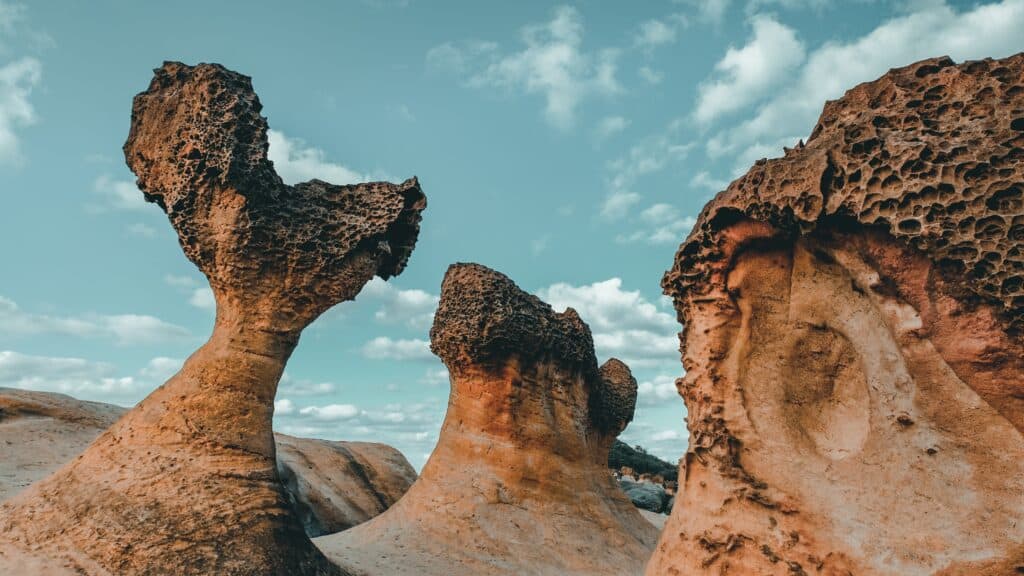
Yehliu Geopark
Located along the rugged coastline of northern Taiwan, Yehliu Geopark is a natural wonderland that showcases the island’s unique geological formations and stunning marine landscapes. This extraordinary park is famous for its otherworldly rock formations, which have been sculpted over millennia by the relentless forces of wind, waves, and erosion.
Getting There: The park is approximately 34km from Taipei so you can either take the public bus from Taipei City Hall Station or hire a car or taxi.
Yingge
Yingge is a charming little town that has earned a reputation as Taiwan’s pottery and ceramics capital. With a history that dates back over 200 years, Yingge has evolved from a small pottery village into a thriving artistic hub.
Yingge’s pottery industry began in the early 19th century when skilled artisans from mainland China settled in the area and introduced their craft to the local residents. Over the years, the town has embraced its artistic roots and transformed itself into a vibrant centre for ceramics production.
A visit to Yingge would not be complete without a stroll down its Ceramics Old Street. This lively pedestrian street is lined with pottery shops, studios, and galleries.
The town also has a Ceramic Museum if you are interested in learning about the history of ceramics. Furthermore, if you want to immerse yourself further you can take a pottery class in one of the many studios.
Getting There: Take the train to Fuxing from Taipei Main Station and get off at Yingge Station.

The Best Beaches Near Taipei
Taipei is easily in reach of some truly stunning beaches making this one of the best things to do outside the city. Here are some of the best beaches closest to the city.
Fulong Beach
Fulong Beach is one of the most famous beaches in Taiwan. Located about one hour away from the city by train along the northeast cost. Visiting this 3km stretch of golden sand is great day out option.
The beach is well maintained and has restrooms and beachside cafes. Water sports like kayaking and windsurfing are also available.
Also, the annual Fulong International Sand Sculpture Art Festival, is held here between May and August. This event showcases intricate sand sculptures created by artists from around the world.
Getting There: The quickest way is by car, the next best option is getting the express train from Taipei’s Main Station to Fulong Station.
Baishawan Beach
Translated as ‘white sand bay’, Basihawan beach is known for its soft sand, clear waters, and picturesque surroundings. The beach is well equipped and great for surfing, especially for beginners as it faces the Taiwan strait so the waves generally are note as strong.
Getting There: To reach Baishawan Beach, take the MRT Tamsui-Xinyi Line (Red Line) from Taipei Main Station to Tamsui Station. From Tamsui Station, board the bus heading towards Baishawan.
Wai’ao Beach
Wai’ao Beach, located in Yilan County, is a haven for surfers and beach lovers. With its black sand coastline and consistent waves, it’s no wonder that this beach is a popular spot for surfing competitions and events.
Getting There: From Taipei Main Station take the train to Wai’ao train station.

To Wrap Up On The Best Things To Do Outside Taipei
There are so many things to do outside of Taipei, from soaking in hot springs, exploring picturesque towns and trails, and visiting the pristine beaches. So when visiting Taipei, make sure you take some time to visit some of the best things to do outside the city.
Check out our great post for the Best Things To Do In Taipei.

